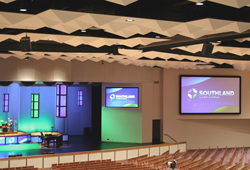
“The new center loudspeaker in the mono cluster is at the centralized location of the original one, but the other two are spread apart significantly,” Roggow explains.
“This provides several advantages.
These loudspeakers are closer to the audience, so there is additional presence, while the added separation also dramatically lessens the impact of interaction between the loudspeakers.
“Specifically, it curtails the mid- and high-frequency phase cancellations that can hamper adjacent loudspeakers, making it sound much more pleasant to the human ear,” he adds.
“We’re talking about the elimination of 10 dB drops in certain frequency sections, so you could say it is much more smooth, all while providing 300 degrees of total horizontal coverage, blanketing this huge room.”
The four loudspeakers in the left-right, left-right stereo aspect of the system were replaced with Tannoy VQ60 loudspeakers, offer similar performance parameters to the VQ100s, but with a narrower (60-degree) horizontal dispersion pattern.
“The biggest difference I’ve noticed is in the stereo system. The VQ60 is a punchy box, very present,” notes Clifton Grimm, a member of the Southland Christian Church technical team.
“The really nice thing is that now things are able to keep their location in the stereo image, and still be pushed to the foreground acoustically if the need arises.
“A perfect example would be a brief vocal lead out – one of the team members leads a line or a portion of a verse – and now a slight fader bump and they sound as if they are standing directly in front of you.
It’s truly that big of a difference. The stereo image is very clean.”
Steve Shewlakow of MGA, who served as installation supervisor on both the original system and the upgrade project, notes that the new VQ60 loudspeakers were able to be placed in the exact same locations as their predecessors, further streamlining the process.
“We did need to adjust the azimuth of the new loudspeakers a bit, to account for and maximize their coverage in comparison to what was provided by the former loudspeakers,” Shewlakow says. “But this is actually a fairly minor adjustment in terms of time and effort.”
Shewlakow also oversaw one other addition to the system that, again, led to another dramatic difference in terms of performance: the addition of two Tannoy VS218DR low-frequency loudspeakers (subwoofers).
These self-powered units (non-powered version also available), each incorporating dual 18-inch drivers in a robust birch hardwood cabinet, are centrally mounted on the grid above the platform, in a tight array to enhance coherency.
The subwoofers receive a separate feed from the house console, affording the operators more individual tailoring and control.
“All of the rigging infrastructure was in place, so other than changing the position of the mono boxes and adding the subs, the installation was straightforward,” he adds.
“In fact, we actually allocated more time that we needed.

